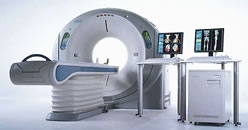|
Medicare Reverses Decision to Limit Coverage of Cardiac CT Heart Scans (updated)
|
 |
March 15, 2008 -- To the
relief of many in the cardiology and radiology community,
the Centers for Medicare and Medicaid Services (CMS) announced
this week that
it will
not
change
current
coverage
for Computed Tomographic Angiography, commonly called Multislice
CT Scan, Cardiac CT or
CT Angiography (CTA). In December
CMS had proposed a National Coverage Decision (NCD) memo,
calling for significant cut-backs in reimbursement for CTA,
covering only
symptomatic patients
and only
in
the context of an approved Clinical Trial.
After the original proposal was announced, there
was an intense outpouring of concern by the various stakeholders
in the cardiac
imaging community. Over 600 comments
were posted to the CMS web site from a wide range of radiologists,
cardiologists and
patients, almost universally calling for CMS to re-think this change.
Mainly through the efforts of the of The
Society of Cardiovascular Computed Tomography (SCCT), 79 Members
of the House of Representatives signed a letter to CMS
to express concern about the proposed NCD and almost
a dozen U.S. Senators wrote to CMS with their concerns.
Novel suggestions
included that of Dr.
Armin Zadeh of Johns Hopkins Medical Center, who invited
the CMS team to visit his lab to see a true state-of-the-art
CT facility. A
joint letter was submitted by most of the major
medical societies concerned with heart disease and imaging. Angioplasty.Org
also posted an
open letter to CMS,
pointing to the increased patient safety afforded by this non-invasive
test for arterial blockage.

An Aquilion
64-Slice CT Scanner,
photo
courtesy Toshiba America Medical Systems |
|
At the heart of
most criticisms was the fact that CMS had been working with
older data and had
not looked at the most current results of important clinical
trials, such as the CorE
64 and others -- trials which proved,
among other things, the very high 99+% negative predictive value
of 64-slice Cardiac CT. Multislice CT is a relatively new technology,
one that is advancing every month.
The feeling among imaging specialists was that a great deal
was at stake here because, as Dr. Daniel S. Berman, President-Elect
of the SCCT told Angioplasty.Org, "There is very strong
evidence that the CT coronary angiogram is the most accurate
non-invasive test for the detection of coronary artery disease.
Period! Nothing comes close." |
Dr. John McBarron Hodgson, past-president of
the
Society
for Cardiovascular Angiography and Interventions, capsulized
CMS' concerns to Angioplasty.Org:
"CMS is afraid that everybody's
going to stack tests -- that you'd get a CT, then a nuclear
stress test, then an invasive cath. So, in our most recent letter,
we have this consortium of radiologists and interventional
and nuclear cardiologists and general bodies, and everybody's
in there together saying cardiac CT is good, don't mess with
it! We're doing good here!
"And we now have papers that are going
to be presented soon, and the data's really amazing. I mean,
you can predict outcome, and we've gone on record now to say
that if you have a normal
cardiac CT, you do not need any other tests. So, that's the
kind of stuff that CMS is really interested in, that we will
come out and say Hey, if you've got a negative
CT, you don't need all these other tests. |
|

John McBarron
Hodgson, MD |

Michael Poon,
MD |
|
The various societies felt that
it was their role to reassure and inform CMS about the latest
trial results, as well as the guidelines currently in place.
Angioplasty.Org recently spoke with Dr. Michael Poon, current
president of the SCCT, who told us:
"We are not advocating doing this on everybody. We are not
advocating doing
CTA on a
patient
who is asymptomatic. We have very clear guidelines, based on
the published Appropriateness
Criteria. I was on the writing
committee and we specifically stated that this test is indicated
in patients with symptoms suggestive of the presence coronary
artery disease, in lieu of doing invasive angiography, which
is a test that can be 30-40% negative for coronary artery disease." |
In addition to cost, concern has also been raised
about radiation exposure from multislice CT -- the subject of a number
of studies. But radiation exposure is a moving target, as technological
advances continue. For example, a technique called ECG-gating is
now used by some, in which the X-rays are sychronized with the heartbeat
and
are only
emitted during a small part of the
heart's motion cycle. Toshiba recently introduced "Dynamic Volume
CT" with a 320-slice scanner which the company has said can reduce
the patient's radiation exposure by a fifth because it is able to
scan the entire heart in a single beat. Dr. Hodgson states that with
modern techniques, the radiation exposure is far less than that of
a nuclear stress test, one of the most commonly-administered diagnostic
exams -- and one which he no longer uses. Radiation from Cardiac
CT, he continues, has become the same or less than that of conventional
catheter-based
angiography,
and
avoids
the complications from the more invasive technique.
Although CMS is leaving the current coverage in
place, it included a number
of
recommendations
and requests
for further study in this week's decision. In its conclusion,
CMS stated:
"CMS wishes to foster the necessary health
outcomes research and establish evidence-based diagnostic strategies
by encouraging affected
Medicare patients to enroll in rigorously designed studies. Absent
any reported additional serious patient harms, further national
coverage reconsideration of coronary CTA will depend upon peer-reviewed
publication
and critical evaluation of convincing new evidence.
"Additionally, we believe that current guidelines
are inadequate to provide appropriate guidance to patients and
providers as to the
appropriate inclusion of CTA into the diagnostic milieu in the
workup of chest pain. We are concerned that providers are using
CTA as an
additional test added to exercise testing and nuclear imaging
rather than thoughtfully considering the appropriate mix of these
tests.
We encourage the specialty societies to quickly develop this
type of guidance."
(Originally Reported on March 12, 2008 by Burt
Cohen, Angioplasty.Org -- updated on March 15)
|



